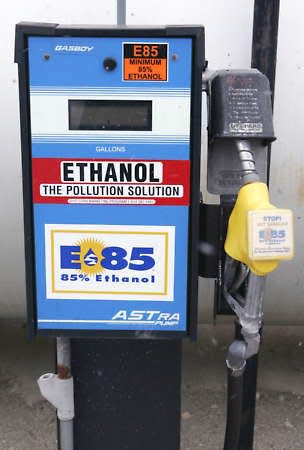Opinion: Unleaded 88, E85 help lower your cost at pump. Congress can help ethanol do more.

Tadd Nicholson is executive director for the Ohio Corn and Wheat Growers Association.
Throughout history, farming has been the backbone of Ohio’s economy, with 77,000 farms, 10 million acres of farmland and endless corn fields spanning across the state.
Harvest is wrapping up for many, and farmers are working to ensure families from Cincinnati to Cleveland have food on their table and fuel for their vehicles.
More:Unleaded 88 fuel is spreading in Ohio, but is it good for your car and the climate?
It’s been a tough year, and farmers have been on the frontlines of some of the nation’s biggest challenges.
Record-high inflation, volatile energy markets and a growing climate crisis continue to challenge our country and our farms. Fuel prices hit Ohio especially hard this spring, reaching a record $5.06 per gallon in June.
Today, the average price of regular gas in Ohio is $3.25 per gallon. While down significantly from the previous high, it is still higher than it was this time last year.
Gas prices are experiencing a recent surge as demand increased nationally throughout the past month, and with OPEC’s recent announcement to cut output by 2 million barrels per day. When the price of oil rises, gasoline prices will too.
Letters: Unleaded 88 fuel comes with a hidden, heavy price
Fortunately for Ohio drivers, an increasing number of retailers across the state now offer higher ethanol blends.
These retailers sell lower-cost and lower-emission E15, a 15 percent ethanol blend, often marketed as Unleaded 88, as well as E85 for use in flex-fuel vehicles.
The proof that blending more ethanol lowers fuel prices is at the pump, where the national average savings on E15 was 30 cents per gallon between June and September, when fuel prices were at their highest. At some Ohio location this summer, drivers paid as much as 80 cents less per gallon for the higher ethanol blend Unleaded 88.
Drivers are continuing to save this fall.
We applaud Gov. Mike DeWine for his decisive action this year that guarantees consumers will have access to cleaner, more affordable fuels for years to come.
Farmers are contributing to energy and economic solutions because we’re producing corn more efficiently and sustainably than ever before, providing the food, feed and fuel Americans need.
Why does this matter?
Ethanol, made from field corn rather than the sweet corn we eat, is key to providing long-term energy security — lowering prices at the pump, reducing dependence on foreign energy sources and cutting greenhouse gas and tailpipe emissions.
What’s more, continued ethanol production empowers thriving farms and rural economies.
Ohio is the seventh largest ethanol producing state in the nation, making it a leader in advancing the renewable fuels that are key to a cleaner energy future. Across the state’s seven ethanol plants, 40 percent of the state’s corn is processed into ethanol without reducing important stocks for food and animal feed.
A bushel of corn yields 2.8 gallons of ethanol, and the ethanol production process also yields more than 15 pounds of quality high-protein livestock feed, distillers corn oil for biodiesel production and biogenic CO2 that can be recycled for beverages and food processing.
Coupled with corn growers’ increasing yields, this value-added production process enables farmers to meet both food and fuel demands with bushels to spare, making it possible for corn growers to both feed and fuel our nation.
Corn growers are helping make progress with lower-cost and lower-emission E15. And there’s more Congress could do to advance ethanol as a longer-term solution to the nation’s energy and climate challenges.
How can Congress help?
The Next Generation Fuels Act would establish a clean, high-octane standard for gasoline, ultimately expanding access to ethanol, increasing America’s fuel supply and offering consumers more affordable choices at the pump. Senator Sherrod Brown and Representatives Tim Ryan and Marcy Kaptur have already signed on as supporters of this legislation.
This is the kind of innovative solution we need to address the dual challenge of energy affordability and climate change, and it’s not just good for the economy and the environment. It’s also good politics.
Morning Consult conducted a poll earlier this year that found 60% of Americans view ethanol as a solution to increasing America’s energy independence and helping the U.S. reach its goal for net zero carbon emissions. Likewise, 58% of respondents believe ethanol is a solution to keeping gas prices down.
In the face of immense challenges, Buckeyes stick together.
That is especially true of our farmers. Through economic downturns, global pandemics, and now an energy crisis, farmers do our utmost to make life better for Americans. Policymakers can do their part to help us expand affordable, clean fuel choices at the pump.
Tadd Nicholson is executive director for the Ohio Corn and Wheat Growers Association.
This article originally appeared on The Columbus Dispatch: How could Next Generation Fuels Act benefit Ohio's farmers with ethanol
